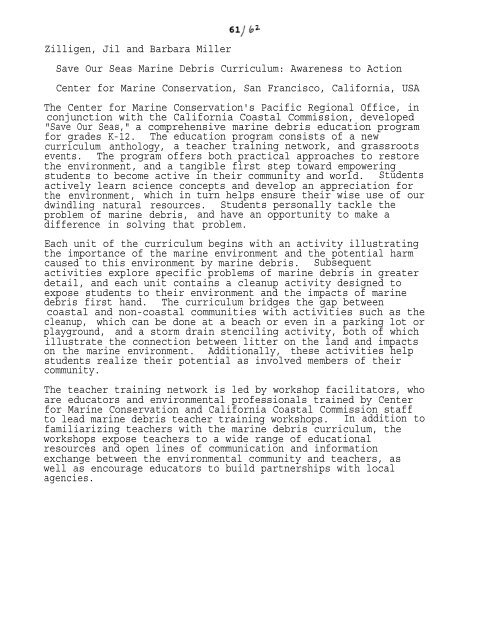Poster abstracts and manuscripts from the Third International ...
Poster abstracts and manuscripts from the Third International ...
Poster abstracts and manuscripts from the Third International ...
Create successful ePaper yourself
Turn your PDF publications into a flip-book with our unique Google optimized e-Paper software.
Zilligen, Jil <strong>and</strong> Barbara Miller<br />
Save Our Seas Marine Debris Curriculum: Awareness to Action<br />
Center for Marine Conservation, San Francisco, California, USA<br />
The Center for Marine Conservation's Pacific Regional Office, in<br />
conjunction with <strong>the</strong> California Coastal Commission, developed<br />
"Save Our Seas," a comprehensive marine debris education program<br />
for grades K-12. The education program consists of a new<br />
curriculum anthology, a teacher training network, <strong>and</strong> grassroots<br />
events. The program offers both practical approaches to restore<br />
<strong>the</strong> environment, <strong>and</strong> a tangible first step toward empowering<br />
students to become active in <strong>the</strong>ir community <strong>and</strong> world. Students<br />
actively learn science concepts <strong>and</strong> develop an appreciation for<br />
<strong>the</strong> environment, which in turn helps ensure <strong>the</strong>ir wise use of our<br />
dwindling natural resources. Students personally tackle <strong>the</strong><br />
problem of marine debris, <strong>and</strong> have an opportunity to make a<br />
difference in solving that problem.<br />
Each unit of <strong>the</strong> curriculum begins with an activity illustrating<br />
<strong>the</strong> importance of <strong>the</strong> marine environment <strong>and</strong> <strong>the</strong> potential harm<br />
caused to this environment by marine debris. Subsequent<br />
activities explore specific problems of marine debris in greater<br />
detail, <strong>and</strong> each unit contains a cleanup activity designed to<br />
expose students to <strong>the</strong>ir environment <strong>and</strong> <strong>the</strong> impacts of marine<br />
debris first h<strong>and</strong>. The curriculum bridges <strong>the</strong> gap between<br />
coastal <strong>and</strong> non-coastal communities with activities such as <strong>the</strong><br />
cleanup, which can be done at a beach or even in a parking lot or<br />
playground, <strong>and</strong> a storm drain stenciling activity, both of which<br />
illustrate <strong>the</strong> connection between litter on <strong>the</strong> l<strong>and</strong> <strong>and</strong> impacts<br />
on <strong>the</strong> marine environment. Additionally, <strong>the</strong>se activities help<br />
students realize <strong>the</strong>ir potential as involved members of <strong>the</strong>ir<br />
community.<br />
The teacher training network is led by workshop facilitators, who<br />
are educators <strong>and</strong> environmental professionals trained by Center<br />
for Marine Conservation <strong>and</strong> California Coastal Commission staff<br />
to lead marine debris teacher training workshops. In addition to<br />
familiarizing teachers with <strong>the</strong> marine debris curriculum, <strong>the</strong><br />
workshops expose teachers to a wide range of educational<br />
resources <strong>and</strong> open lines of communication <strong>and</strong> information<br />
exchange between <strong>the</strong> environmental community <strong>and</strong> teachers, as<br />
well as encourage educators to build partnerships with local<br />
agencies.
















